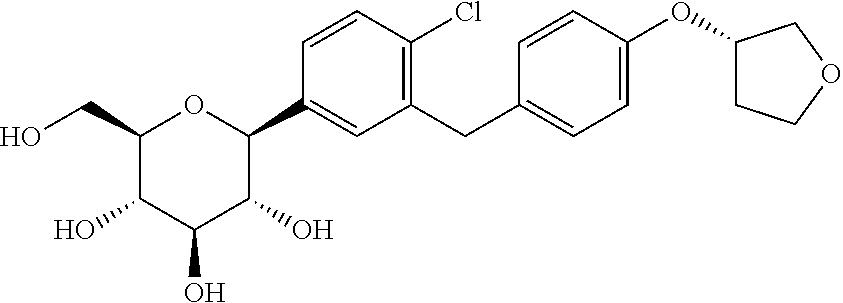Pharmaceutical composition, methods for treating and uses thereof
a technology of pharmaceutical compositions and sglt2 inhibitors, applied in the field of sglt2 inhibitors, can solve the problems of reducing the capacity of the kidneys to excrete waste products
- Summary
- Abstract
- Description
- Claims
- Application Information
AI Technical Summary
Benefits of technology
Problems solved by technology
Method used
Image
Examples
example 1
Empagliflozin in Patients with Type 2 Diabetes Mellitus (T2DM) and Renal Impairment (RI)
[0352]A Phase III trial investigated the efficacy and safety of empagliflozin (EMPA) as add-on to existing therapy for 52 weeks in patients with T2DM and RI. Patients with mild RI (eGFR [MDRD equation]≧60 to 2) received EMPA 10 or 25 mg qd or placebo (PBO). Patients with moderate RI (eGFR 30 to 2) received EMPA 25 mg qd or PBO. Patients with severe RI (eGFR 5 to 2) received EMPA 25 mg qd or PBO.
[0353]In patients with type 2 diabetes and mild renal impairment, treatment with empagliflozin 10 and 25 mg at week 52 resulted in a small decrease in eGFR. However, mean eGFR increased to a value slightly above baseline at the 3-week follow up visit in the empagliflozin treatment groups; in contrast, in the placebo group, mean eGFR further decreased (Table 1A).
TABLE 1ADescriptive statistics for eGFR over time in patientswith mild renal impairmentEmpaEmpaPlacebo10 mg25 mgNumber of patients 32 (100.0)41 (10...
example 2
Empagliflozin in Hypertensive Patients with Type 2 Diabetes Mellitus (T2DM)
[0356]A Phase III trial investigated the efficacy and safety of empagliflozin (EMPA) administered orally, once daily over 12 weeks in hypertensive patients with T2DM (EMPA 10 or 25 mg, placebo (PBO)). Patients with a systolic blood pressure (SBP) of 130 to 159 mmHg and a diastolic blood pressure (DSP) of 80 to 99 mmHg were included in the trial.
[0357]Treatment with empagliflozin 10 and 25 mg at week 12 resulted in a small decrease in eGFR. However, mean eGFR increased to a value slightly above baseline at the 2-week follow up visit in the empagliflozin treatment groups; in contrast, in the placebo group, mean eGFR remained slightly below baseline (Table 2).
TABLE 2Descriptive statistics for eGFR (MDRD) over timeEmpaEmpaPlacebo10 mg25 mgBaseline eGFRN* (%)238 (100)241 (100)244 (100)Mean (SD) 84.47(17.06)83.01(16.43)83.97(17.85)[mL / min / 1.73 m2]Last value ontreatment eGFRN* (%)237 (99.6)238(98.8)240 (98.4)Mean (S...
example 3
Empagliflozin in Patients with Type 2 Diabetes Mellitus (T2DM) Receiving Treatment with Basal Insulin
[0358]A Phase IIb trial investigated the efficacy and safety of empagliflozin (EMPA 10 or 25 mg, placebo (PBO)) administered orally, once daily over 78 weeks in patients with T2DM receiving treatment with basal insulin (glargine, detemir, or NPH insulin only).
[0359]Treatment with empagliflozin 10 and 25 mg resulted in a small decrease in eGFR. However, mean eGFR increased to a value slightly below baseline at the 4-week follow up visit in the empagliflozin treatment groups; in contrast, in the placebo group, mean eGFR further slightly decreased (Table 3).
TABLE 3Descriptive statistics for eGFR (MDRD) over timeEmpaEmpa Placebo10 mg25 mgNumber of patients, 170 (100.0)169 (100.0)155 (100.0)N (%)Baseline eGFRN1 (%)170 (100.0)169 (100.0)155 (100.0)Mean (SD)83.89 (22.73)85.01 (23.63)82.88 (25.46)Week 18 eGFRN1 (%)134 (78.8)133 (78.7)113 (72.9)Mean (SD)80.07 (20.15)80.37 (23.03)79.11 (21.63)...
PUM
| Property | Measurement | Unit |
|---|---|---|
| waist circumference | aaaaa | aaaaa |
| waist circumference | aaaaa | aaaaa |
| waist circumference | aaaaa | aaaaa |
Abstract
Description
Claims
Application Information
 Login to View More
Login to View More - R&D
- Intellectual Property
- Life Sciences
- Materials
- Tech Scout
- Unparalleled Data Quality
- Higher Quality Content
- 60% Fewer Hallucinations
Browse by: Latest US Patents, China's latest patents, Technical Efficacy Thesaurus, Application Domain, Technology Topic, Popular Technical Reports.
© 2025 PatSnap. All rights reserved.Legal|Privacy policy|Modern Slavery Act Transparency Statement|Sitemap|About US| Contact US: help@patsnap.com

